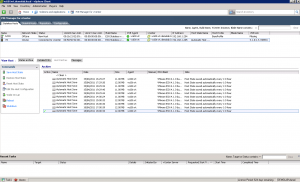Thought I would write a quick how to step by step guide on how to deploy vCloud Connector and configure the plug-in with vCenter. Once I have collected them all, I will update the article with the associated screenshots. Deploying the Appliance from OVF Extract the contents of the vCC zip file Login to the Management Group vCenter and select Deploy OVF Template from the File menu Enter the full path of the vcc OVF that was extracted previously and click Next Confirm the details by clicking Next Accept the license agreement and click Next Provide a name for the Virtual Machine and select a Inventory Location, and click Next Select a host or cluster on which to run the vCloud Connector appliance and click Next Select a resource pool and click Next Select a datastore and click Next Select either Thin provisioned or Thick provisioned format and click Next […]
Tag Archives | edge
VMworld 2011 – Voting Closed #1264 Private vCloud Architecture Deep Dive
Voting is now closed for VMworld 2011. Please vote for my session #1264 titled “Private vCloud Architecture Technical Deep dive”. This presentation won an award at PEX 2011, and I hope that people will give me the opportunity to present this again. http://www.vmworld.com/index.jspa Session Abstract Enterprises globally are enthusiastically embracing Cloud Computing as both a way of reducing costs and improving the quality of service IT provides to its end customers. To achieve this, enterprises are looking to VMware and its partners to help them deploy VMware vCloud Director-based Private Cloud environments. For a VMware vCloud Director-based Private Cloud to be successful and operationally sustainable, an absolutely critical first step is developing a solid vCloud architecture. This session will help partners address this critical first step by exploring the proven, practical activities and considerations VMware has defined, based on experience, for developing a vCloud architecture. A participant in this session […]
Critical Patch Information for ESX/ESXi 3.5 Hosts – Apply before June 1 2011
For anyone out there still using ESX(i) 3.5 you will need to apply a specific patch to your hosts to be able to continue updating these after June 2011. This patch updates a secure key which will allow future patches to be applied. Follow the links below to the VMware KB articles for further information. KB: 1030001 Critical Impact: VMware ESX 3.5, Patch ESX350-201012410-BG: Apply this patch to continue applying patches on ESX 3.5 hosts after June 2011 has been written for users of ESX. KB: 1030002 Critical Impact: VMware ESXi 3.5, Patch ESXe350-201012401-I-BG: Apply this patch to continue applying patches on ESXi 3.5 hosts after June 2011 has been written for users of ESXi.
Memory problems occur when a host uses more than 1016 dvPorts on a vDS
A few people have been talking about this lately, and what it actually means. Within the vSphere 4.1 U1 release notes the following statement has been made: Memory problems occur when a host uses more than 1016 dvPorts on a vDS * Although the maximum number of allowed dvPorts per host on vDS is 4096, memory problems can start occurring when the number of dvPorts for a host approaches 1016. When this occurs, you cannot add virtual machines or virtual adapters to the vDS. Workaround: Configure a maximum of 1016 dvPorts per host on a vDS. So what does this mean exactly? If a portgroup is created with 2000 dvPorts, how would this be created on a host? Would it create 2000 dvPorts for every host in the vDS? The Answer is NO. A host will only have the maximum number of configured proxy ports, which by default is 256. […]

PXE Manager for VMware vCenter
Today VMware have officially released PXE Manager for VMware vCenter written by Max Danieri. Max works in the Technical Services Cloud Practice. Before joining VMware Max wrote products like VMTS Patch Manager PXE Manager for vCenter enables ESXi host state (firmware) management and provisioning. Specifically, it allows: * Automated provisioning of new ESXi hosts stateless and stateful (no ESX) * ESXi host state (firmware) backup, restore, and archiving with retention * ESXi builds and VMtools management (only stateless ESXi) * Multi vCenter support * Multi network support with agents (Linux CentOS virtual appliance) * Wake on Lan for any host * Hosts memtest and inventory * vCenter plugin and much more… You can download the application by clicking here
